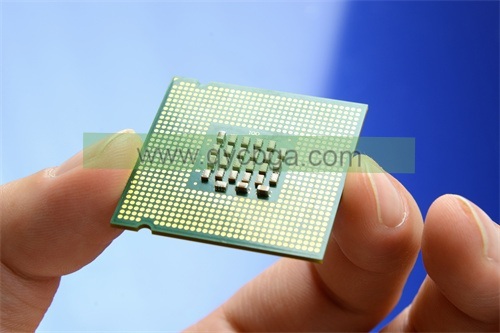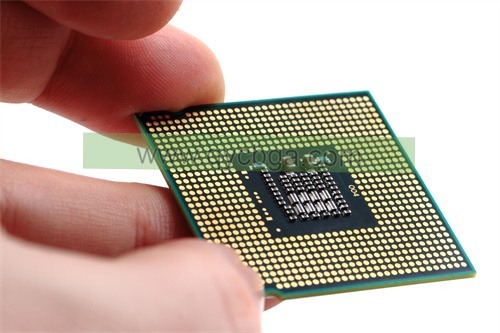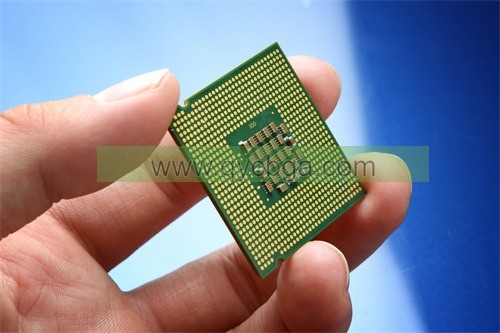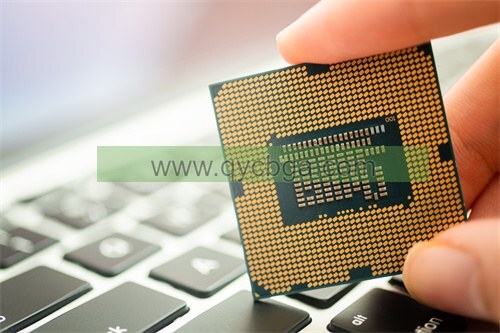Что такое субстрат для пакета MIS?
Производитель подложек для пакетов MIS,НЕ (Формованная межблочная подложка) package substrate is a sophisticated solution for compact and high-performance electronic assemblies. This substrate integrates both circuitry and mechanical structures into a single molded component, reducing the need for additional layers and connectors. MIS substrates offer excellent electrical performance, механическая стабильность, and thermal management. They are commonly used in automotive, medical, и бытовая электроника, where space-saving and reliability are crucial. Typically constructed from materials like epoxy resin or thermoplastics, MIS package substrates enable efficient manufacturing processes and facilitate the development of miniaturized and durable electronic devices, ensuring optimal performance in various applications.
НЕ (Metal-Insulator-Semiconductor) package substrate refers to a type of packaging substrate used in semiconductor devices. It’s a foundational component in integrated circuits, providing a platform for mounting and connecting semiconductor chips within a package.
The MIS package substrate typically consists of several layers, including metal layers, insulating layers, and semiconductor layers. The metal layers are used for interconnections between the semiconductor devices and external circuitry. The insulating layers provide electrical isolation between different components on the substrate. The semiconductor layer, often silicon, may be used for various purposes such as device integration or additional functionality.
Полный, the MIS package substrate plays a crucial role in the performance, надёжность, and thermal management of semiconductor devices by providing electrical connections and structural support while insulating different components from each other.

Производитель подложек для пакетов MIS
MIS Package Substrate design Reference Guide.
Designing an НЕ (Metal-Insulator-Semiconductor) package substrate requires careful consideration of various factors to ensure optimal performance, надёжность, и технологичность. Here’s a reference guide outlining key aspects of MIS package substrate design:
- Выбор материала: Choose materials for each layer of the substrate based on their electrical, термический, и механические свойства. Common materials include silicon for the semiconductor layer, insulating materials like silicon dioxide or silicon nitride, and various metals for the interconnection layers.
- Конфигурация слоев: Determine the optimal configuration of metal, insulator, and semiconductor layers based on the specific requirements of the semiconductor device. Consider factors such as signal routing, Распределение питания, and thermal management.
- Interconnection Design: Design the interconnection layout to minimize signal delay, переходный разговор, and power losses. Use techniques such as impedance matching, signal shielding, and proper ground and power distribution to optimize electrical performance.
- Signal Integrity: Perform signal integrity analysis to ensure that the substrate design meets the required electrical specifications, such as signal timing, voltage levels, and noise margins. Use simulation tools to model signal behavior and validate the design.
- Thermal Management: Incorporate features such as thermal vias, Радиаторы, and thermal pads to efficiently dissipate heat generated by the semiconductor devices. Ensure that the substrate design can handle the thermal load without exceeding temperature limits that could degrade device performance or reliability.
- Технологичность: Design the substrate with manufacturability in mind, considering factors such as layer alignment, registration accuracy, and process compatibility with fabrication techniques such as photolithography, офорт, and deposition.
- Соображения по поводу надежности: Решение проблем надежности, таких как механические нагрузки, electromigration, and thermal cycling by optimizing the substrate design and selecting appropriate materials and fabrication processes. Perform reliability testing to validate the design under various operating conditions.
- Package Integration: Coordinate the substrate design with the overall package design to ensure compatibility with assembly processes and external interfaces. Consider factors such as package size, form factor, and compatibility with standard packaging technologies.
- Documentation and Guidelines: Document the substrate design thoroughly, including specifications, layout diagrams, fabrication instructions, and design guidelines. Provide clear guidelines for manufacturing, собрание, тестирование, and quality assurance to ensure consistency and reliability in production.
- Iterative Optimization: Continuously iterate on the substrate design based on feedback from simulation, тестирование, and manufacturing experience to improve performance, надёжность, and cost-effectiveness over time.
By following these guidelines and best practices, you can design MIS package substrates that meet the stringent requirements of modern semiconductor devices while ensuring high performance, надёжность, и технологичность.
What are the materials used in MIS Package Substrate?
Materials used in НЕ (Metal-Insulator-Semiconductor) package substrates are selected based on their electrical, термический, и механические свойства. Common materials include:
- Semiconductor Layer: Silicon is often used as the semiconductor material due to its compatibility with semiconductor fabrication processes and its excellent electrical properties.
- Insulating Layer: Insulating materials such as silicon dioxide (SiO2), Нитрид кремния (Си3Н4), and various types of polymers are used to provide electrical isolation between different components on the substrate. These materials also offer good thermal stability and mechanical strength.
- Metal Layers: Various metals such as aluminum (Al), медь (Cu), and gold (Au) are used for interconnection layers to route electrical signals between semiconductor devices and external circuitry. These metals are chosen for their high conductivity, low resistivity, and compatibility with microfabrication processes.
- Dielectric Layer: Dielectric materials such as polyimide or benzocyclobutene (BCB) may be used as additional insulating layers or as a substrate material for multi-layer structures. These materials provide electrical insulation and mechanical support while allowing for the integration of through-silicon vias (TSVs) and other advanced packaging features.
- Passivation Layer: Passivation materials such as silicon nitride (Си3Н4) or silicon oxide (SiO2) are applied to protect the underlying semiconductor devices from environmental factors such as moisture, contaminants, and mechanical damage.
- Adhesive Layer: Adhesive materials such as epoxy or polyimide are used to bond the substrate to other components of the package assembly, providing mechanical stability and ensuring reliable electrical connections.
By carefully selecting and integrating these materials, MIS package substrates can be designed to meet the demanding requirements of modern semiconductor devices, including high-speed operation, Управление температурным режимом, и надежность.
How is MIS Package Substrate manufactured?
The manufacturing process of MIS (Metal-Insulator-Semiconductor) package substrates involves several steps, including substrate preparation, material deposition, patterning, and assembly. Вот общий обзор производственного процесса:
- Подготовка основания:
– The manufacturing process typically begins with the preparation of a substrate material, such as a silicon wafer or a glass panel. The substrate is cleaned and treated to ensure surface cleanliness and uniformity.
- Material Deposition:
– Various materials are deposited onto the substrate in thin film form using techniques such as physical vapor deposition (PVD), Химическое осаждение из газовой фазы (ССЗ), or atomic layer deposition (ALD).
– Semiconductor layers, insulating layers, metal layers, and other functional layers are sequentially deposited onto the substrate according to the design specifications.
- Patterning:
– Photolithography is used to define patterns on the deposited layers. A photoresist material is applied to the surface, exposed to light through a photomask, and developed to selectively remove portions of the photoresist.
– The exposed areas of the underlying layers are then etched away using wet or dry etching processes, leaving behind the desired patterned features such as metal interconnects, Вьяс, and insulation layers.
- Integration and Interconnection:
– After patterning, additional layers may be deposited and patterned as needed to build up the structure of the substrate.
– Through-silicon vias (TSVs) may be formed to provide vertical interconnections between different layers of the substrate.
– The semiconductor devices (chips) are typically attached to the substrate using bonding techniques such as flip-chip bonding or wire bonding. Adhesive materials may be used to secure the chips in place.
- Packaging and Assembly:
– Once the substrate is fully fabricated, it is integrated into the overall semiconductor package assembly.
– Additional components such as heat sinks, lids, and external connectors may be attached to the package as needed.
– The package is then sealed and encapsulated with a protective material, such as epoxy or molding compound, to provide mechanical strength and environmental protection.
- Тестирование и контроль качества:
– The finished packages undergo rigorous testing to ensure they meet the required electrical, термический, and mechanical specifications.
– Testing may include electrical continuity testing, signal integrity testing, Термоциклирование, and reliability testing under various operating conditions.
Следуя этим производственным шагам, MIS package substrates can be produced with high precision and reliability to meet the demanding requirements of modern semiconductor devices.
The Application area of MIS Package Substrate
НЕ (Metal-Insulator-Semiconductor) package substrates find application in various areas of the semiconductor industry, particularly in the assembly and packaging of integrated circuits (HCR) and microelectronic devices. Some common application areas include:
- Microprocessors and Microcontrollers: MIS package substrates are widely used in the packaging of microprocessors and microcontrollers for computing devices, including desktop computers, Ноутбуки, servers, and embedded systems. These substrates provide electrical connections, Управление температурным режимом, and mechanical support for the semiconductor chips.
- Memory Devices: MIS package substrates are utilized in the packaging of memory devices such as dynamic random-access memory (DRAM), static random-access memory (SRAM), and flash memory. These substrates enable high-speed data transfer, compact form factors, and reliable operation of memory modules in various electronic devices.
- Graphics Processing Units (GPUs): In graphics cards and other high-performance computing applications, MIS package substrates play a critical role in packaging GPUs and providing efficient thermal management for handling the high power dissipation associated with graphics processing.
- System-on-Chip (SoC) Приборы: MIS package substrates are essential components in the packaging of SoC devices, which integrate multiple functions onto a single chip. These substrates enable the integration of diverse components such as processors, memory, analog circuits, and wireless communication modules into compact and power-efficient packages.
- Networking and Communication Devices: MIS package substrates are used in networking equipment, routers, switches, and communication devices to package high-speed interfaces, Ethernet controllers, wireless transceivers, and other components critical for data transmission and connectivity.
- Автомобильная электроника: In the automotive industry, MIS package substrates are employed in the packaging of electronic control units (Экю), Датчики, actuators, and other components used in vehicle systems such as engine control, safety systems, infotainment, and driver assistance systems.
- Электроника: MIS package substrates are found in a wide range of consumer electronics products, в том числе смартфоны, Таблетки, wearables, digital cameras, gaming consoles, and home appliances, where they provide the necessary packaging and interconnection solutions for semiconductor devices.
- Industrial and Medical Electronics: MIS package substrates are utilized in industrial automation, robotics, Медицинские приборы, instrumentation, and control systems, where they offer reliability, durability, and performance required for harsh operating environments and critical applications.
Полный, MIS package substrates play a crucial role in the assembly, packaging, and integration of semiconductor devices across various industries, enabling the development of advanced electronic systems with enhanced functionality, performance, и надежность.
What are the advantages of MIS Package Substrate?
НЕ (Metal-Insulator-Semiconductor) package substrates offer several advantages in the semiconductor industry, making them a preferred choice for packaging integrated circuits and microelectronic devices. Некоторые из ключевых преимуществ включают в себя:
- Электрические характеристики: MIS package substrates provide excellent electrical properties, including low parasitic capacitance, resistance, and inductance, enabling high-speed signal transmission and reduced signal degradation. This results in improved device performance and signal integrity.
- Миниатюризация: MIS package substrates support the integration of multiple semiconductor devices, Пассивные компоненты, and interconnects into compact and densely packed packages. This enables the miniaturization of electronic systems, reducing space requirements and allowing for the development of smaller and lighter devices.
- Управление температурным режимом: MIS package substrates offer effective thermal management solutions, including the integration of thermal vias, Радиаторы, and thermal pads, to dissipate heat generated by semiconductor devices. This helps in maintaining optimal operating temperatures, prolonging device lifespan, and ensuring reliable performance under high-temperature conditions.
- Надёжность: MIS package substrates are designed to meet stringent reliability requirements, including mechanical robustness, thermal stability, and resistance to environmental factors such as moisture, влажность, и термоциклирование. This ensures the long-term reliability and durability of semiconductor devices, even in demanding applications.
- Индивидуализация и гибкость: MIS package substrates can be customized to meet specific design requirements, в том числе материалы подложки, layer configurations, interconnection schemes, and package sizes. This flexibility allows for the development of tailored solutions optimized for various applications and performance metrics.
- Экономичность: MIS package substrates offer cost-effective packaging solutions compared to alternative packaging technologies such as ceramic packages or chip-scale packages. The use of standard semiconductor fabrication processes and materials helps in reducing manufacturing costs while maintaining high quality and performance.
- Совместимость: MIS package substrates are compatible with a wide range of semiconductor fabrication processes, including CMOS (Complementary Metal-Oxide-Semiconductor), BiCMOS (Bipolar CMOS), and MEMS (Micro-Electro-Mechanical Systems), allowing for seamless integration with existing manufacturing workflows and technologies.
- Scalability: MIS package substrates support scalable designs that can accommodate future technology advancements, including higher device densities, increased functionality, and improved performance. This scalability enables the development of next-generation semiconductor devices and electronic systems with enhanced capabilities.
Полный, the advantages of MIS package substrates make them an attractive choice for packaging semiconductor devices, offering improved electrical performance, миниатюризация, Управление температурным режимом, надёжность, flexibility, cost-effectiveness, compatibility, and scalability.
How Much Does MIS Package Substrate Cost?
The cost of MIS (Metal-Insulator-Semiconductor) package substrates can vary widely depending on several factors, including the complexity of the substrate design, the choice of materials, the manufacturing process used, and the volume of production. Here are some factors that can influence the cost:
- Сложность конструкции: Сложность конструкции подложки, в том числе количество слоев, the density of interconnects, the presence of through-silicon vias (TSVs), and the integration of advanced features such as thermal management solutions, can impact the cost. More complex designs may require specialized fabrication techniques and materials, which can increase manufacturing costs.
- Выбор материала: The choice of materials for the substrate layers, including semiconductor materials, insulating materials, metal interconnects, and passivation layers, может повлиять на стоимость. Some materials may be more expensive or require specialized processing techniques, adding to the overall cost of the substrate.
- Производственный процесс: The manufacturing process used to fabricate the substrate, including deposition, patterning, офорт, bonding, and packaging steps, can influence the cost. Advanced fabrication techniques such as photolithography, Химическое осаждение из газовой фазы (ССЗ), and atomic layer deposition (ALD) may incur higher equipment and operational costs.
- Объем производства: The volume of production plays a significant role in determining the cost of MIS package substrates. Higher volumes typically lead to economies of scale, as fixed costs such as equipment setup, tooling, and overhead expenses are spread out over a larger number of units, resulting in lower per-unit costs.
- Supplier and Location: The choice of supplier and manufacturing location can impact the cost of MIS package substrates. Suppliers with advanced manufacturing capabilities and lower labor or overhead costs may offer more competitive pricing.
- Additional Services: Additional services such as design support, тестирование, quality assurance, and customization may incur additional costs but can add value to the overall package.
It’s essential to consider these factors and work closely with substrate manufacturers to optimize the design and production process to achieve the desired balance between cost, performance, and reliability for specific semiconductor applications.
FAQs about MIS Package Substrate
What is an MIS package substrate?
An MIS package substrate is a foundational component used in semiconductor packaging to mount and connect semiconductor chips within a package. It typically consists of metal, insulator, and semiconductor layers.
What are the advantages of using MIS package substrates?
MIS package substrates offer advantages such as excellent electrical performance, миниатюризация, effective thermal management, надёжность, Гибкость настройки, cost-effectiveness, compatibility, and scalability.
What materials are used in MIS package substrates?
Materials commonly used in MIS package substrates include silicon for the semiconductor layer, insulating materials such as silicon dioxide or silicon nitride, various metals for interconnection layers, dielectric materials, passivation materials, and adhesive materials.
How are MIS package substrates manufactured?
The manufacturing process typically involves substrate preparation, material deposition, patterning, integration, собрание, тестирование, and quality assurance. Various fabrication techniques such as deposition, photolithography, офорт, and bonding are used to create the substrate structure.
What are the applications of MIS package substrates?
MIS package substrates find applications in microprocessors, Устройства памяти, graphics processing units (GPUs), system-on-chip (SoC) приборы, networking and communication devices, Автомобильная электроника, consumer electronics, industrial and medical electronics, и многое другое.
What factors influence the cost of MIS package substrates?
The cost of MIS package substrates depends on factors such as design complexity, material selection, Производственный процесс, Объем производства, supplier, location, and additional services.
How can I optimize the design and production of MIS package substrates for my specific application?
Optimizing the design and production of MIS package substrates involves considering factors such as electrical performance, Управление температурным режимом, надёжность, Потребности в настройке, Ограничения по стоимости, and scalability requirements. Working closely with substrate manufacturers and leveraging their expertise can help achieve the desired balance between these factors.
 Производитель подложек для упаковки FCBGA
Производитель подложек для упаковки FCBGA







